Addressing Racism and Anti-Blackness in Asian-American Communities: A Dialogue
On Tuesday, December 1st, Virginia Secretary of Education, Atif Qarni, hosted a virtual discussion moderated by the Chairwoman of the Virginia Asian Advisory Board to Governor Northam, May Nivar. According to the event flyer, they convened “a panel of experts for a conversation on how racism and anti-Blackness manifest in AAPI communities.”
The panel included: 10th-District State Senator, Ghazala Hashmi, a South Asian and Muslim woman; Assistant Teaching Professor at Georgetown University’s McCourt School of Policy, Dr. Wesley Joe, a Korean-American; Washington, D.C. area director of the National Korean American Service and Education Consortium VA (NAKASEC), Sookyung Oh; and Associate Professor of Gender, Sexuality and Women’s Studies at Virginia Commonwealth University (VCU), Dr. Archana Pathak, an Indian born scholar-activist.
 Secretary Qarni introduced the event by sharing his feeling that “the biggest issue left in education for us, is to tackle school segregation.” This issue, among others, would be revisited throughout the panel’s discussion.
Secretary Qarni introduced the event by sharing his feeling that “the biggest issue left in education for us, is to tackle school segregation.” This issue, among others, would be revisited throughout the panel’s discussion.
Nivar, the event’s moderator, followed up Qarni’s introduction by stating, “school segregation is a serious matter.” She went on to highlight a recent study conducted by VCU and Penn State University, which found that, “segregation by race and poverty is deepening in VA.” Nivar began the panel discussion by stating, “There’s this popular image of Asian-Americans, as a ‘model minority.’” She posed the following question to the panelists: “What is it and where did it come from?”
The first to respond was Dr. Pathak, who described how part of the ‘model minority’ myth is to view Asian-Americans as a homogeneous group whose purpose here in America is to be this economic powerhouse that stays insular within their own communities, away from Black and Brown communities. Pathak pointed out that the panel composition alone contradicts the idea of Asian-Americans as homogeneous.
Dr. Wesley added, “Many people are shocked to learn that some Korean-Americans in northern Virginia are undocumented, low income folks,” and that, “1 out of 7 Asian Americans is undocumented and yet we’re no where in the DACA debate,” further eroding the ‘model minority’ concept’s accuracy.
Several issues further complicate the roles Asian-Americans play within America’s social fabric, including the topic of affirmative action, which is often criticized as having a negative impact on Asians studying in the United States. Pathak noted, “We are often taught to think of things like equity as a finite pie” when analyzing social policies. The panelists also discussed the idea of meritocracy, which Wesley defined as the idea that “scarce goods. . .should be allocated on the basis of Merit.” Hashmi connected the current American concept of meritocracy back to “Puritan mythology” which “has really ingrained itself, in a non-theological way, in our society.”
Nivar moved the discussion toward the ways in which racism and anti-Blackness have “manifested in our community.” She noted that Asian-Americans are dubbed as “honorary whites” leaving them to be “the invisible minority” and mentioning that she’s been asked “Are Asians even people of color?”
Pathak approached the issue from a structural perspective, “We tend to think of white supremacy as the KKK” she said of the Asian-American’s thinking. She talked about how “white supremacy has its roots in global Anglo colonial systems” and reinforces “this idea that those Anglo ways of being. . . are considered normal.” Leading “those of us in non-dominant positions,” meaning various racial and ethnic minorities in the U.S. to “push against each other.” Causing people like herself to “become a weapon, deployed in a war I never signed up for.”
Bringing the conversation to more current events, Nivar asked the panelists,“Tell me what went through your head when you found out one of the four police officers in the George Floyd murder was Asian.”
In response to Nivar’s line of questioning, Oh shared that, “On one hand knowing that one of the officers complicit in Mr. Floyd’s death was Asian American, did little to unsettling me, knowing he’s a police officer. On the other hand, I do think for some Asian Americans, that image of this Mong-American officer standing with his back turned as a white officer killed Mr. Floyd that, it became a symbol, it became a symbol of Asian Americans being complicit in anti-Blackness.” Forcing people within the Asian-American community to ask themselves, “Are we going to turn our backs to racism and anti-Blackness or are we going to confront it?”
Senator Hashmi agreed, stating,“That picture became a metaphor really, with the officer having his back, while another human being was murdered. That complicity was deeply disturbing to see. But I think it would have been deeply disturbing no matter the background or ethnicity of the police officers.” Hashmi added, “We shouldn’t hold this officer to any higher moral standard or any lower expectation just because he’s Asian American. . . I don’t hold him responsible because he’s Asian American, I hold him responsible as a human being.”
For Pathak, it was a reminder of the Rodney King uprisings in Los Angeles, which she called “A significant event that shaped my life in many ways.” Pathak recalled that, “About four months prior [to the riots] an Asian American shop owner had shot a young African American girl who was shopping in a convenience store.”
The panelists shared thoughts about the relationship between Asians and Black people in the U.S.
Hashimi recollected, “As soon as we arrived, literally got off the plane, my brother and I were admitted into an all white school. When we went to see our doctor, we were able to sit in the white waiting room and my parents were able to purchase a house in a white neighborhood. These were distinct privileges that were denied to the generations of the Black families that had actually lived and worked and toiled in those farms. Who had built that community with their sweat, literally their blood.”
Although each immigrant group to America has faced their own discrimination “We’ve never ever faced the kind of deep-seated harmful bigotry that Black people in this country have faced” said Hashmi.
Bringing it back to the present Hashmi said, “As long as we continue to allow that to happen, without acknowledging the fact that we have been privileged because we’re able to distinguish ourselves against Black people, then we’re part of that perpetuation.”
Pathak added, “Some of us were able to immigrate to this county because the Civil Rights Act included a component of it that reversed the Johnson-Reed Act that abolished Asian American immigration to the United States. . .It’s not like in post-1965 a bunch of Asians suddenly decided let’s come to America sounds like a good plan, it was because it was finally legal.
“And why did it become legal? It became lateral because of a decade, at least a decade prior, of work by African-American communities to pass certain laws that desegregated the United States. That said the United States is a place for diversity and inclusion in these ways and we will now pass policy that allows for us to happen.”
In response, Nivar asked, “Do we even see a lot of that history, our history, or even Black history, in the textbooks, in the history? and “How have these biases impacted Virginia’s education system?”
Wesley said the “development of empathy” occurs through “everyday interactions.” Thus without integrated schools and communities people continue to lack empathy for their fellow community members.
Hashmi declared, “We have to desegregate schools, we have to desegregate neighborhoods, we have to desegregate our lives, and until we actually lead desegregated lives that our children see and they can emulate, we’re going to continue down this path.” According to the study by VCU and Penn State, “we have more segregation now than we did 40 years ago in the commonwealth.”
“What are some concrete things going forward we can do to champion this work?” Nivar asked. She encouraged the panelists to share “strategies and resources you would suggest to those who wish to pursue anti-racist policies and to embody anti-racist principles in our daily lives.”
Pathak said, “Part of doing this work is having the conversation within our own communities. . .Learning the history of the land we live in, live on, and benefit from is integral to us becoming better citizens of that society. . .It has to start at home, in our own families, in our own neighborhoods, in our own communities.”
Oh wants people to “literally work with Black communities.” She also thinks people should “take some time to think about what is an attack and what isn’t.”
Reiterating Oh’s point, Wesley said “Wanting to desegregate a school so that kids have a greater opportunity to develop empathy with people of other walks of life, that is not an attack on Asian-Americans.”
He also believes dialogues such as this one are very important. “We need to resist the cultural conditioning to be on the sidelines. We need to become more involved. We need to press our school board members and other elected officials to push for integrative educational opportunities. And we also need to push our other local officials and state elected officials to reform our housing policy because housing policy is school policy. An awful lot of the segregation in our school system is a result of the zoning laws and some of the pathologies of the affordable housing industry.”
Wesley also said, “We have to reorganize the unique place of African-Americans, in particular the descendants of slaves as opposed to recent immigrants from Africa, and the legacy of slavery and the impact that has had on folks in Virginia and elsewhere in the United States. We need to be more familiar with that history. That’s particularly true for new Americans I think. It’s not just another marginalized community. It’s three centuries of another kind of holocaust. And I think unless we understand that, we are going to miss the mark. And we are always going to underestimate the extent of the obstacles that confront the descendants of slaves as they try to navigate the education system and build life prospects for themselves and their families.”
Hashmi added, “We can do things that will help to dismantle generations of systemic racism and the ways in which our societies are structured to continue that level of segregation and oppression.” She encouraged Virginians to read and understand the history that is all around them and concluded, “If you haven’t engaged with the communities and the people around you, I think it’s time to start that. I think it’s time to open our houses and our welcoming spaces so that we can talk to each other directly and have these conversations.”




One thought on “Addressing Racism and Anti-Blackness in Asian-American Communities: A Dialogue”
Comments are closed.